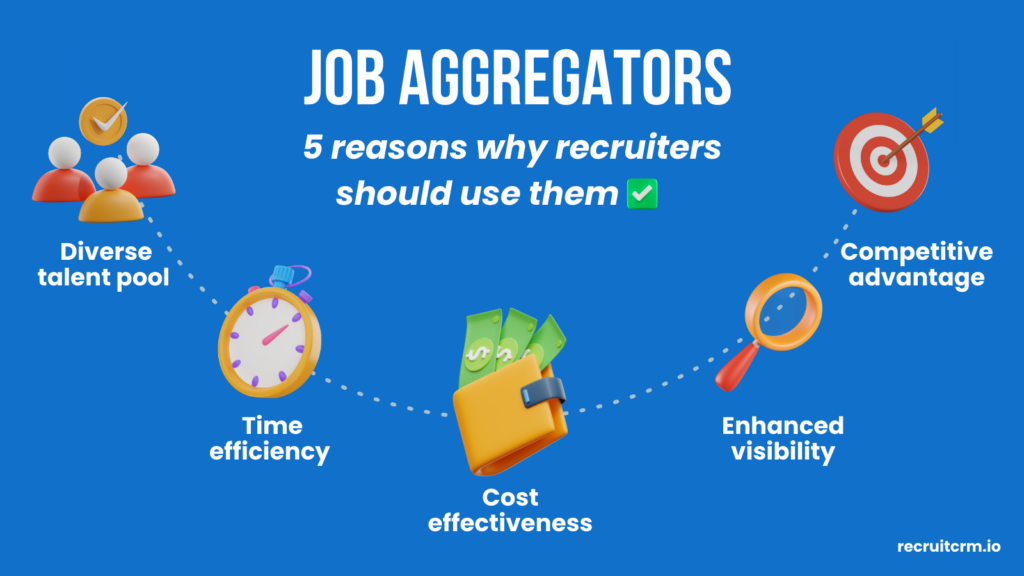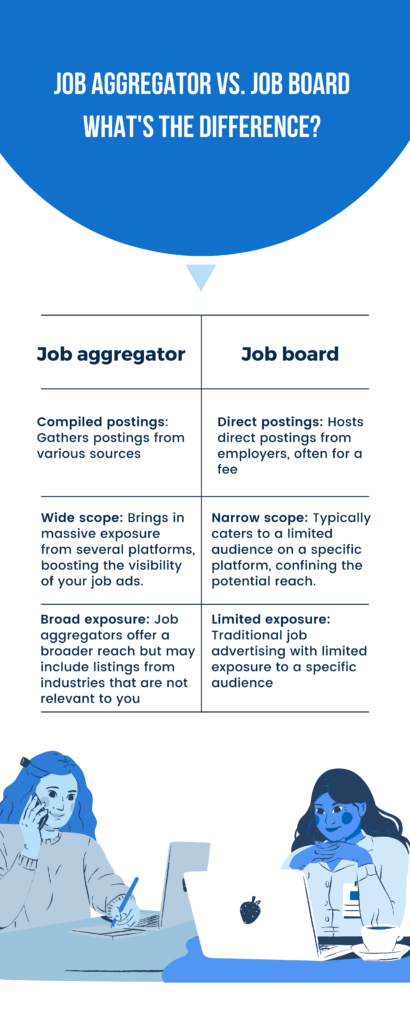Candidate sourcing is one of the fundamental pillars of a successful hiring strategy.
Yet, it is also one of the MOST challenging procedures, giving recruiters a hard time gaining reach and visibility.
So, here’s the game-changer– job aggregators.
This all-in-one platform makes candidate sourcing significantly more efficient and effective, putting an end to all your hiring nightmares.
Wondering how? Read on.
What is a job aggregator?
A job aggregator is very similar to a bustling marketplace where job listings from every nook and cranny of the internet come together.
It effectively scrapes and collects job postings from various platforms—job boards, company websites, and even social media.
Now, you’re probably asking– this is made for job seekers. Why should I care?
Well, that’s where the plot thickens.
Job aggregators aren’t just for candidates; they’re a goldmine for recruiters, too.
Let’s find out how.
5 reasons why recruiters should consider using job aggregators

1. Diverse talent pool
The first and foremost reason is the diversity of the talent pool.
Job aggregators attract millions of candidates from various backgrounds, skills, and geographies.
Whether you’re looking for a software developer in San Francisco or a graphic designer in New York, you’ll find them all here.
The diversity isn’t just in terms of skill sets but also experience levels, from fresh graduates to industry veterans.
2. Time-efficiency
Time is money when it comes to recruitment; every second counts.
Job aggregators save you hours by centralizing job listings from multiple platforms into one searchable database.
No more juggling between different job boards or sifting through hundreds of emails.
One search can yield hundreds of relevant job seekers.
3. Cost-effectiveness
Let’s talk numbers.
Posting a job ad on a traditional job board can cost anywhere between $100 to $500.
Most job aggregators, on the other hand, are free or significantly cheaper.
Some even offer pay-per-click options, allowing you to control your spending while maximizing reach.
You might also like: How to ace your recruitment efforts even with a tight budget
4. Enhanced visibility
Using a job aggregator means your job ads won’t just get lost in the crowd; they’ll be in a big, easy-to-search pool.
This enhanced visibility means that your job posting is more likely to be seen by the right candidates, increasing your chances of making a successful hire.
5. Competitive edge
In a saturated job market, standing out is crucial.
Job aggregators give you that edge by amplifying the reach of your job postings.
While your competitors are still figuring out the best platform to post their job ads, you’ve already cast a wide net, capturing a diverse range of candidates.
How do job aggregators work in favor of recruiters? 7 perks to benefit from
Job aggregators majorly function through a complex web of algorithms and codes that are constantly and tirelessly working behind the scenes.
These algorithms gather job listings from various platforms, including job boards, company recruitment websites, and even social media.
Once gathered, these listings are categorized based on a variety of parameters—industry, job role, location, experience level, and more.
The result?
A neatly organized and searchable database that’s updated in real-time.
Here are some of the essential boxes it ticks off.
1. Automated sourcing
The first perk that comes to mind is automated sourcing.
Gone are the days of manual searches and endless scrolling.
Job aggregators do the grunt work for you, pulling in job seekers who match your criteria.
All you need to do is set your preferences, and that’s it!
A curated list of candidates is ready to be served.
2. Quality over quantity
We’ve all been there—sifting through a mountain of applications, most of which are irrelevant.
Job aggregators come with advanced filters that ensure you’re not piled up with applications that miss the mark.
You can hand-pick candidates based on skills, experience, location, and even salary expectations.
3. Data analytics
Recruiters genuinely appreciate working with actionable metrics.
Some job aggregators offer insightful analytics that help you gauge the performance of your job ads.
From click-through rates to application rates, these stats offer a bird’s-eye view of how your recruitment strategy is falling in place.
You might also like: Recruitment data analytics for perfect candidate selection
4. Global reach
If you are primarily targeting the global talent pool, job aggregators have got you covered.
With listings from around the world, these platforms offer a global reach that’s hard to match.
Whether you’re hiring locally or internationally, a job aggregator is your key to a world of talent.
5. SEO benefits
Most job aggregators are readily SEO-optimized. Thus, your ads, when posted on these platforms, get the best push as well.
It makes your job posts easily discoverable by candidates who are actively searching for opportunities online.
6. Passive candidate attraction
Not all job seekers are active on job boards, but they may stumble upon your listing on an aggregator.
This opens doors to a passive talent pool who might not be actively seeking a job but are open to new opportunities.
7. Branding
Last but not least, employer branding.
Some job aggregators allow for customized job ads, complete with your company logo and branding guidelines.
This not only makes your job ads more appealing but also helps in building brand recognition.
Because candidates aren’t just looking for a job; they’re looking for a place where they can grow and thrive.
Job aggregator vs. job board: What’s the difference?
While both serve as platforms for job opportunities, they operate in distinct ways and cater to different needs.
Let’s explore the key differences that set them apart.

5 top job aggregator sites you NEED to try out

1. Indeed
Indeed—the OG of job aggregators.
With a global reach and a user-friendly interface, Indeed offers a series of features, including analytics and resume databases.
But what sets it apart is its sheer volume of listings, making it a one-stop-shop for all your recruitment needs.
You might also like: How to post a job on Indeed? Follow these 6 steps
2. SimplyHired
Two words that describe SimplyHired well are versatile and ever-evolving.
Known for its robust filters and social media integration, SimplyHired makes it easy to share job listings across various platforms.
Plus, it offers salary insights based on job titles and locations, giving you an edge in crafting competitive offers.
3. CareerJet
CareerJet is a “do-it-all” platform that scans over 58,000 websites daily and is available in 28 languages.
If you’re looking to diversify your talent pool, especially with multilingual job seekers, CareerJet should be your go-to.
4. LinkedIn Jobs
LinkedIn is not just for networking anymore; its job aggregator feature is a force you must embrace.
Leveraging professional networks, LinkedIn Jobs offers a unique angle to the traditional job search, providing quality candidates who come with a stamp of approval from their peers (the social proof of “endorsements”).
5. Glassdoor
Glassdoor is one of the most popular hubs for job listings. With its unique focus on company culture and employee satisfaction, Glassdoor attracts a different kind of job seeker—one who values transparency and work-life balance.
This gives you the opportunity to not only source candidates but also to showcase your company’s culture and values.
Plus, Glassdoor offers detailed analytics and competitor insights, allowing you to stay ahead of the game in the recruitment landscape.
6. Monster
Known for its advanced search algorithms, Monster allows recruiters to find candidates who are not just qualified but are also a cultural fit for the company.
With features like candidate matching and real-time analytics, Monster takes the guesswork out of recruitment.
How do you optimize your posting for job aggregators? 7 tips to success
The basics
1. Keyword-rich titles
The job title is the first thing candidates see.
Make it leave an impact by using relevant keywords.
Instead of “Marketing Guru,” go for “Digital Marketing Manager.”
It’s not just about being clear; it’s about being searchable.
2. Compelling meta descriptions
Most job aggregators show a snippet of the job description.
This is your meta description.
Make it compelling and informative to entice job seekers to click and learn more.
The essentials
3. Detailed job descriptions
Once the candidate clicks, you’ve got to keep them hooked.
A detailed job description that outlines responsibilities, qualifications, and benefits is key.
The more specific you are, the better the match you’ll find.
You might also like: Master job descriptions in 9 easy steps [+ 5 free templates]
4. Location-specific approach
Always include the job location, even if it’s remote.
Many candidates filter their search by location.
Don’t miss out on potential matches by skipping this crucial detail.
The advanced
5. Mobile optimization
89% of job seekers vouch for the importance of mobile optimization in their job search process.
Ensure your job postings are mobile-friendly.
A clunky job ad that isn’t compatible with different screen sizes is a surefire way to lose potential candidates.
6. Social sharing buttons
Make it easy for job seekers to share your job postings on various social media platforms.
An easy-to-share job ad can gain an immense volume of reach.
It’s free marketing!
7. Call to action
End your job posting with a strong call to action.
Whether it’s “Apply Now” or “Send us your resume,” a clear CTA increases the likelihood of a candidate taking the next step.
6 best practices for recruiters when it comes to using job aggregators
1. Stay updated
The job market is highly dynamic.
New roles emerge, and old ones evolve.
Keep your job listings updated to reflect these changes.
An outdated job ad is an instant turn-off, showcasing a sheer lack of effort.
2. Be selective
It’s tempting to post on every job aggregator out there- but focus on the ones that work for YOUR specific needs.
Choose only those platforms that align with your target audience and industry.
A bullseye approach is the safest one to rely on.
3. Keep testing
Don’t just set it and forget it.
Experiment with different titles, descriptions, and CTAs to see what resonates with your audience.
Use the analytics provided by the aggregator to refine your strategy.
4. Allocate your budget
Many job aggregators offer premium features at a cost.
Allocate your budget wisely.
Take it from the analytics in hand to identify which platforms give you the best ROI and invest accordingly.
You might also like: How can data optimize your small recruitment budget?
5. Be aware
Ensure that your job ads comply with legal requirements, such as non-discriminatory language.
A lawsuit is the last thing you want on your plate.
6. Seek feedback
Encourage candidates to provide feedback on the application process.
This can offer invaluable insights into any bottlenecks or pain points that may be deterring quality job seekers.
With job aggregators at play, recruiters can gain exposure and traction from different corners of the globe, elevating the hiring game to a whole new level.
It’s only prudent to tap into the endless potential of this platform (definitely with the help of our handy guide) and source candidates effectively and efficiently, making the best out of your available resources.
Frequently asked questions
1. Are job aggregators better than job boards?
It’s not a matter of better or worse; it’s about what suits your needs.
Job boards are more specialized but have a limited reach.
Job aggregators offer an all-in-all platform that broadens the reach, attracting more diverse set of candidates.
2. Can the analytics provided by job aggregators be trusted?
While not as comprehensive as specialized analytics tools, the metrics provided by job aggregators are generally reliable for gauging the performance of your job ads.
3. How do I choose the right job aggregator?
Consider factors such as industry relevance, geographical reach, and budget.
Some aggregators specialize in specific industries or regions, while others offer premium features at a cost.
6. What are the common pitfalls to avoid?
The most common pitfalls include using vague job titles, neglecting to update job ads regularly, and failing to track performance through analytics.




